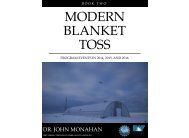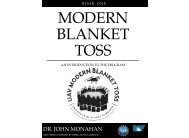Modern Blanket Toss: Findings and Observations
This book is the last in a series of three covering the National Science Foundation awarded Modern Blanket Toss project. In this book are the evaluation findings for each of the three years as well as observations from Modern Blanket Toss staff.
This book is the last in a series of three covering the National Science Foundation awarded Modern Blanket Toss project. In this book are the evaluation findings for each of the three years as well as observations from Modern Blanket Toss staff.
You also want an ePaper? Increase the reach of your titles
YUMPU automatically turns print PDFs into web optimized ePapers that Google loves.
2016 FINDINGS<br />
The <strong>Modern</strong> <strong>Blanket</strong> <strong>Toss</strong> student outcomes were organized around themes<br />
common to informal science education: interest or engagement; self-efficacy<br />
(sense of ability); awareness, knowledge or underst<strong>and</strong>ing; <strong>and</strong> behavior changes<br />
(National Science Foundation, 2008; National Research Council, 2009; Phillips et<br />
al., 2014). In addition, the outcomes were organized around predictors of<br />
students’ STEM success, including high school math <strong>and</strong> science courses taken<br />
(Hinojosa et al., 2016) <strong>and</strong> the grades in those courses. The program also<br />
included an outcome for student communication <strong>and</strong> leadership skills, the<br />
development of which was a primary part of the planned program.<br />
Many of the program’s expected student outcomes were met, indicating that<br />
students who participated in the <strong>Modern</strong> <strong>Blanket</strong> <strong>Toss</strong> program are now more<br />
likely to pursue college degrees in STEM areas <strong>and</strong> ultimately pursue STEM<br />
careers. Students reported significant increases in their knowledge of <strong>Modern</strong><br />
<strong>Blanket</strong> <strong>Toss</strong> content areas, such as how to use GIS mapping software, <strong>and</strong><br />
longer duration of participation in the program led to greater content gains.<br />
Students also reported significant gains in their underst<strong>and</strong>ing of science<br />
practices, such as asking a scientific question from data. Students reported<br />
significant increases in their communication skills, such as their ability to talk to a<br />
group of strangers.<br />
Those target student outcomes that did not achieve a statistically significant<br />
change, still nonetheless increased. For example, many of the students already<br />
had a positive attitude toward science when they started, so the overall attitude<br />
toward science scale score, while shifting positively, did not shift to a statistically<br />
significant degree. Similarly, students reported positive increases in leadership<br />
skills, but these increases were not statistically significant. Again, students entered<br />
the program with relatively high leadership scale scores, so statistically significant<br />
results may have been difficult to detect with the small sample size. In future<br />
iterations of the <strong>Modern</strong> <strong>Blanket</strong> <strong>Toss</strong> program we would recommend collecting<br />
additional outcome data for control group students, such as attitude toward<br />
science. This additional data would allow the program to better assess its<br />
impacts when pre-data shows positive results <strong>and</strong> leaves little room for growth.<br />
Finally, the student grades <strong>and</strong> the number of math <strong>and</strong> science courses<br />
completed in high school did not increase during the evaluation period. This is<br />
not an unexpected result for several reasons. First the sample size was<br />
extremely small <strong>and</strong> it is difficult to find significant relationships from the data as<br />
statistical tests normally require a larger sample size to ensure a representative<br />
distribution of the population. Second, we only measured student grades <strong>and</strong><br />
courses completed over two school years. A longer time period would provide<br />
better data.<br />
However, we did find that students who participated<br />
in <strong>Modern</strong> <strong>Blanket</strong> <strong>Toss</strong> had significantly higher GPAs<br />
<strong>and</strong> science <strong>and</strong> math grades than control group<br />
students. This is telling information. Students who<br />
self-selected to participate in the <strong>Modern</strong> <strong>Blanket</strong> <strong>Toss</strong><br />
summer program already were more likely to pursue<br />
college degrees in STEM areas <strong>and</strong> ultimately pursue<br />
STEM careers simply based on their higher math <strong>and</strong><br />
science grades. This is a factor that should be<br />
considered in any future evaluation.<br />
60




